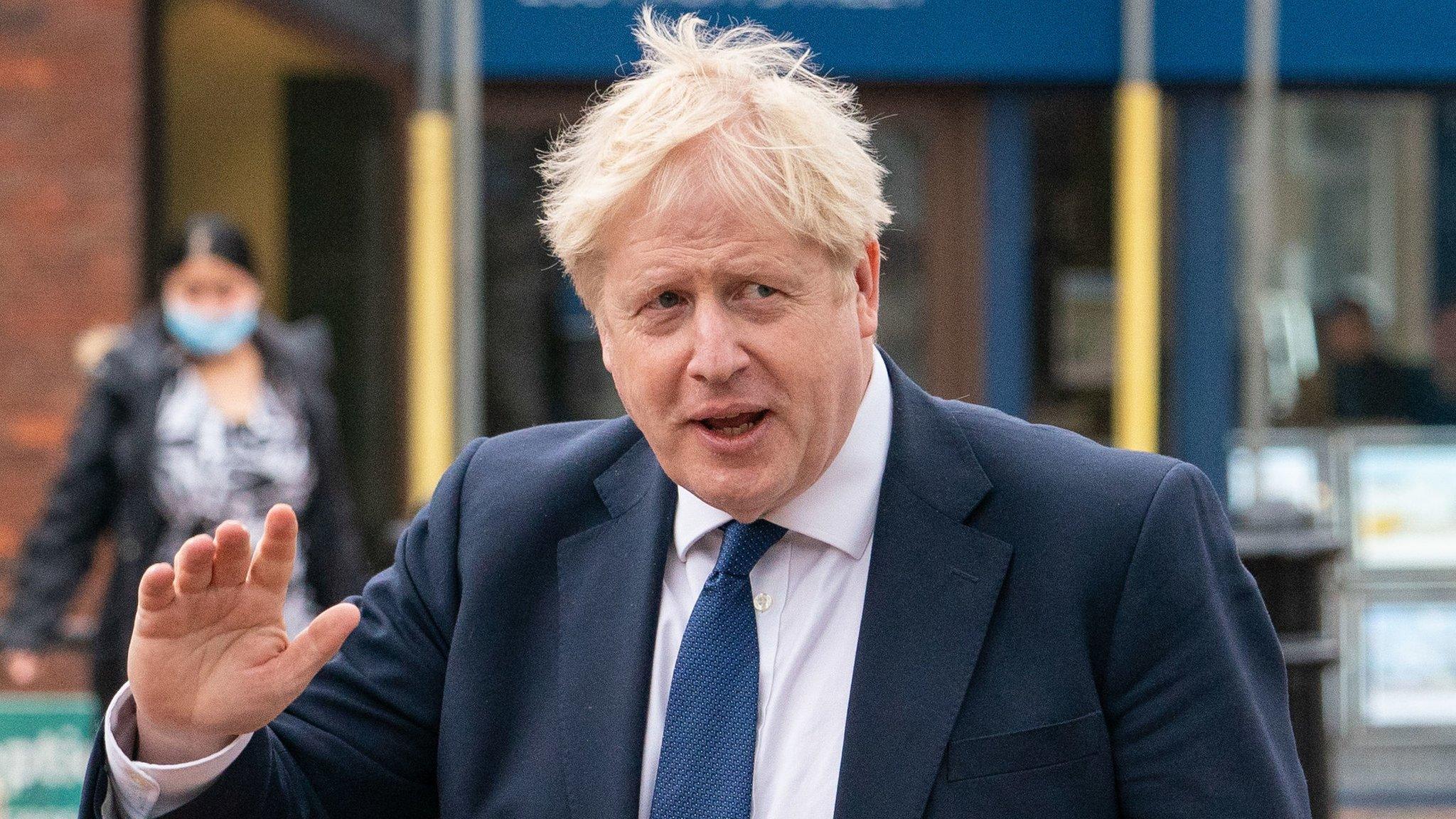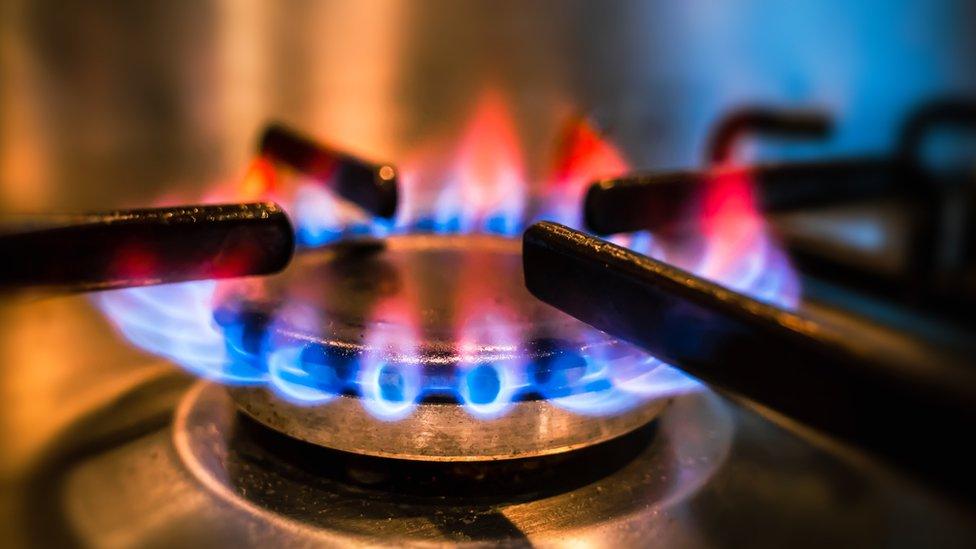How to smooth over the energy price shock
- Published

Prime Minister Boris Johnson is under pressure to act on soaring energy prices and household costs as a jump in capped bills looms in April.
The government has a trilemma over energy prices: how to solve the cost-of-living crisis, while being focussed on net zero, and unwilling to increase taxation or borrowing.
There may be no ideal solution, but a number of questions need clarification.
Who should be shielded from a 50% rise in energy prices and for how long?
Who should bear the burden - bill payers or tax payers? Are we willing to take a hit on government debt?
And do we want to smooth this over 25 years or two or three years?
Imminent rises
The energy price rises that are coming in April and again in the autumn will reach well beyond the "hard-up" or "fuel poor", possibly sending inflation towards an incredible 7%.
This is something not seen in three decades, since well before the independence of the Bank of England.
Such is the scale of the increases in the pipeline - with typical bills heading to £165 a month - that the pressure will affect millions of lower middle-income households as well as poorer ones.
Average households, which currently spend 4% of their disposable income on energy, will see that almost double.
A recent poll suggested that half of Britons would not be able to afford a rise in their monthly bills of £50 a month. That's the increase which is coming in a few week's time.
All of this means there are some fundamental flaws with the three main solutions currently being floated.
Discount expansion
An expansion of the £140 Warm Home Discount scheme is the current most talked-about plan.
The current budget of this scheme is less than £500m a year.
It is not really designed for a situation where several million people might need support to fund a £20bn energy price shock.
The "core" element of the scheme distributes payments automatically to low income elderly using pension credit data.
But there are now more people in the broader part of the scheme for working age recipients of the discount.
This part of the scheme is run on a first-come first-served basis, where recipients have to apply for the discount from a fixed pot of funds at each energy company, and hope that the fund isn't exhausted.
There are some different criteria applicable at each energy company so claimants may not be eligible if they have switched.
The most significant factor, though, is that no funds come from the taxpayer.
It is all funded by the energy companies, or rather, funded from energy bills.
Redistributing half a billion for the fuel poor on to wealthier people's bills is one thing.
Adding several times that, on top of the record increases, starts to assume the character of a new tax.
Cuts to VAT and green levies
A cut in VAT saves 5% or £95 off a £1900 predicted bill. This might prove a helpful addition, but will not fundamentally alter the picture.
It also gives more cash back to those with the biggest bills, or the largest, least well-insulated mansions. And it also loses revenue to the Exchequer.
And then there is getting rid of the "green levies". These are a range of policies that add about £170 to bills.
They reflect the funding for historical investments in green energy, and a range of social obligations.
They would be required instead to be funded by the taxpayer.
A version of this idea was floated four years ago in Professor Dieter Helm's "Cost of energy" report to the government. He said that report had been "shelved".
Putting off costs
There is another solution that the government is looking at: what is being termed a "cost deferral mechanism".
Essentially some big banks, possibly backed by Treasury guarantee, lend billions to energy companies, who then spread a £600 immediate hike, into, say an additional £120 premium every year for five years, or less over a decade.
It is possible to do this without Treasury backing, but some sort of adaptation of rules governing existing deferral arrangements such as the last resort supplier schemes would be needed.
Another version of this scheme being pushed in Whitehall could utilise the pandemic rescue architecture at the Bank of England by providing up-front funding.
This could prove rather controversial, but some argue that the scheme could help prevent inflation getting to 7%.
Some version of the scheme, or "smoothing mechanism", has been gaining traction in the energy sector, in some government departments, and among MPs keen for a plan.
But it doesn't have universal backing in the energy industry.
In an interview with the BBC earlier this week Centrica chief executive Chris O 'Shea referred to it as a "bailout" for energy companies.
That in turn has led to some scepticism at the Treasury about how it can work.
But I understand that plans along these lines are being worked up, with some observers seeing this scheme as the cornerstone of a Prime Ministerial relaunch in the coming weeks.
Short or long-term hike?
The judgement on whether this is a one-off shock, or whether, as Mr O'Shea suggested, it will last two years or more, is critical here.
There are reasons to believe it is the consequence of an exceptional set of circumstances.
Firstly, the post-pandemic bounce-back leading to unprecedented demand, including for gas.
Secondly, the fact that due to a late, cold and long winter last year, crucial stores of gas in Europe never got full in the first place going into this winter.
And lastly there is the Nordstream 2 pipeline from Russia which is finished, but which has not been certified by Germany.
The prediction that wholesale gas prices stay high for a year or two is a reflection of what futures markets are saying.
All of that could change rather rapidly with a speech from Russian President Vladimir Putin, or when the global economy normalises.
But we cannot be certain either way.
If a smoothing mechanism is put into operation, and wholesale prices remain high, then households might get prolonged chronic pain, and a never-ending scheme.
Does the political cycle lend itself to such a spread of the burden with a general election expected in 2024?
All of this points to the traditional moment where Number 10's First Lord of the Treasury - one of the Prime Minister's official titles - overrules a fiscally cautious Chancellor.
But the political backdrop of "partygate" adds some uncertainty to what actually happens here.
The fundamentals are this though: Is this a one-off price shock? And for how long does the government want to spread the energy price pain?
For ordinary households, there couldn't be a more important consequence to the nation's currently delicate political balance.
Related topics
- Published10 January 2022

- Published27 December 2021

